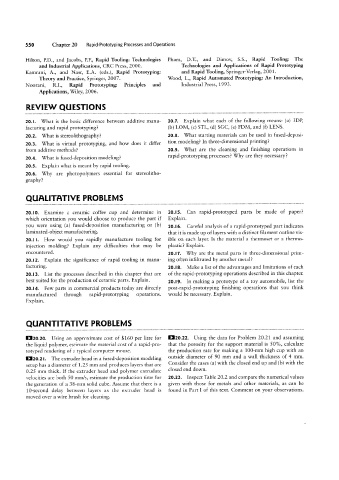Page 570 - 04. Subyek Engineering Materials - Manufacturing, Engineering and Technology SI 6th Edition - Serope Kalpakjian, Stephen Schmid (2009)
P. 570
550 Chapter 20 Rapid-Prototyping Processes and Operations
Hilton, P.D., and ]acobs, P.F., Rapid Tooling: Technologies Pham, D.T., and Dimov, S.S., Rapid Tooling: The
and Industrial Applications, CRC Press, 2000. Technologies and Applications of Rapid Prototyping
Kamrani, A., and Nasr, E.A. (eds.), Rapid Prototyping: and Rapid Tooling, Springer-Verlag, 2001.
Theory and Practice, Springer, 2007. Wood, L., Rapid Automated Prototyping: An Introduction,
Noorani, R.I., Rapid Prototyping: Principles and Industrial Press, 1993.
Applications, Wiley, 2006.
REVIEW QUESTIONS
20.I. What is the basic difference between additive manu- 20.7. Explain what each of the following means: (a) 3DP,
facturing and rapid prototyping? <b) Loivi, <¢> STL, (d) SGC, (Q) FDM, and (f> LENS.
20.2. What is stereolithography? 20.8. What starting materials can be used in fused-deposi-
20.3. What is virtual prototyping, and how does it differ tion modeling? In three-dimensional printing?
from additive methods? 20.9. What are the cleaning and finishing operations in
20.4. What is fused-deposition modeling? rapid-prototyping processes? Why are they necessary?
20.5. Explain what is meant by rapid tooling.
20.6. Why are photopolymers essential for stereolitho-
graphy?
QUALITATIVE PROBLEMS
20.l0. Examine a ceramic coffee cup and determine in 20.I5. Can rapid-prototyped parts be made of paper?
which orientation you would choose to produce the part if Explain.
you were using (a) fused-deposition manufacturing or (b) 20.l6. Careful analysis of a rapid-prototyped part indicates
laminated-object manufacturing. that it is made up of layers with a distinct filament outline vis-
20.1 I. How would you rapidly manufacture tooling for ible on each layer. Is the material a thermoset or a thermo-
injection molding? Explain any difficulties that may be plastic? Explain.
encountered. 20.17. Why are the metal parts in three-dimensional print-
20.|2. Explain the significance of rapid tooling in manu- ing often infiltrated by another metal?
facturing. 20.18. Make a list of the advantages and limitations of each
20.I3. List the processes described in this chapter that are of the rapid-prototyping operations described in this chapter.
best suited for the production of ceramic parts. Explain. 20.l9. In making a prototype of a toy automobile, list the
20.I4. Few parts in commercial products today are directly post-rapid-prototyping finishing operations that you think
manufactured through rapid-prototyping operations. would be necessary. Explain.
Explain.
QUANTITATIVE PROBLEMS
|]20.20. Using an approximate cost of $160 per litre for |]20.22. Using the data for Problem 20.21 and assuming
the liquid polymer, estimate the material cost of a rapid-pro- that the porosity for the support material is 50%, calculate
totyped rendering of a typical computer mouse. the production rate for making a 100-mm high cup with an
outside diameter of 90 mm and a wall thickness of 4 mm.
|]20.2 I. The extruder head in a fused-deposition modeling
setup has a diameter of 1.25 mm and produces layers that are Consider the cases (a) with the closed end up and (b) with the
0.25 mm thick. If the extruder head and polymer extrudate closed end down.
velocities are both 50 mm/s, estimate the production time for 20.23. Inspect Table 20.2 and compare the numerical values
the generation of a 38-mm solid cube. Assume that there is a given with those for metals and other materials, as can be
10-second delay between layers as the extruder head is found in Part I of this text. Comment on your observations.
moved over a wire brush for cleaning.

